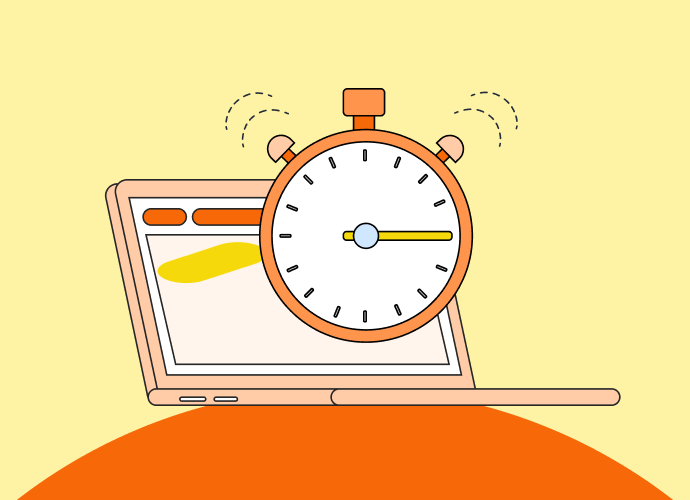Depending on how itŌĆÖs presented, tracking the time your team spent on tasks can be perceived like an act of surveillance or a great enabler of productivityŌĆöand today weŌĆÖre here to make sure your team feels the latter ¤śē ┬Ā
How to introduce time tracking to your team
Very few people get excited about tracking their time (sidenote:┬ĀI do, but I┬Āmay be the exception to your proverbial rule). For most teams, going from a situation where they donŌĆÖt log time or havenŌĆÖt been tracking time consistently to one where time tracking is now a requirement can be a bit of a cultural shock.
The difference between success and failure comes down to how the activity is both presented and implementedŌĆöif you approach time tracking as a tool for empowerment (instead as one for control), you can help your team work smarter, price projects fairly, and keep sustainable workloads.

Based on several conversations we had with our customers and resource manager pros┬Ā(including Eduardo in the screenshot above), here are three key bits of tactical advice for implementing time tracking.┬Ā
1. Start with the WHY┬Ā
Before diving into systems and processes and how-tos, address the elephant in the room: not everyone sees time tracking in the same way. Some team members might interpret it as a sign of surveillance; others might see it as a form of extreme micromanagement, especially when theyŌĆÖre required to track granularly and attribute the time to client campaigns. EU-based folks, given the , might find it a helpful though cumbersome way to protect their work hours, health, and safety.
The key is being straightforward about why time tracking matters for your organization. When teams understand how time tracking helps them work better (not harder), adoption can become easier. Some benefits you may want to discuss include:┬Ā
- Reporting on accurate time against estimates/retainers to understand where money is going
- Identifying the amount of time spent on non-critical tasks
- Enabling more effective time management and resource allocation
- Keeping track of projects and productivity
- Estimating future projects based on previous data
- Billing clients accurately for the work you delivered
¤ōÜ PS:┬Ā covers a lot of excellent and occasionally scary examples of why time tracking is important:┬Ā

2. Choose your approach to time tracking
The next step is communicating how to track time: by task, project, or person. Each serves different goals:┬Ā
- Project-based tracking helps you monitor your resourcing budget (eg. hours spent) and ensure you can accurately bill your clients for completed work. This method is essential if you work with retainers or fixed project budgets, as it gives clear visibility into how much time is being spent against what was quoted.ŌĆŹ
- Task-based tracking helps identify time spent on revenue-generating work versus time spent on admin tasks. You can also better understand the depth of time required for certain pieces of work so you can more accurately estimate future work of the same caliber.
- ŌĆŹPeople-based tracking might reveal individual strengths, helping you assign work to both in-house and freelance staff who excel at specific tasks. With weekly timesheets, you can identify which tasks different team members are most efficient at, in turn optimizing workload distribution and making the right staffing decisions for future projects.
<sme-box>
&▒¶│┘;▓§│Š▒-│”┤Ū▒¶┤Ū░∙=ŌĆØg░∙▒▒▓įŌĆØ&▓Ą│┘;
<sme-image>

</sme-image>
<sme-author>
Martin Mattli
</sme-author>
<sme-position>
Head of Operations and Quality Management at Apps with love
</sme-position>
<sme-quotes>
Apps with love is a digital agency that transformed its operations through smart time tracking using ░Ą═°╔½ŪķŲ¼ (hello ¤æŗ). For years, Head of Operations Martin Mattli relied on a giant spreadsheet to manage projects and schedule his teams, while each employee maintained their individual timesheets; inevitably, this led to inconsistencies, data gaps, and hours wasted on administrative tasks.
Their journey offers a practical blueprint for teams looking to up their time tracking game:
- Start with the problem: instead of mandating time tracking, begin by identifying pain points. For Apps with Love, it was the inefficiency of scattered timesheets and unreliable reporting.
- Choose an intuitive solution: find a tool or solution that reduces friction rather than adding to it. For Mattli, the key was finding software that would pre-fill timesheets from scheduled work, making logging time a one-click process.
After implementing proper time tracking, Apps with love saw a 35% increase in time reporting accuracy per employeeŌĆöand discovered there were roughly 10,000 hours that had previously gone untracked (!)┬Ābecause of the manual entry and human error that come with dozens of people using separate Excel sheets for time tracking.
ŌĆŹ
Read Apps with loveŌĆÖs full story here ŌåÆ
</sme-quotes>
</sme-box>
3. Establish clear guidelines
Success lies in the detailsŌĆöjust ask digital agency AŌĆöB, who achieved nearly 100% time tracking adoption across their team thanks to clear, consistent guidelines everyone could follow.
When setting up your guidelines, include specifics about:
- ŌĆŹWhen to track time: be explicit about whether tracking applies to all tasks or specific projects only. This eliminates confusion and helps your team maintain and reconcile accurate project data.ŌĆŹ
- How to round time logs: modern time tracking allows for really granular logging down to the minuteŌĆöwhich is handy if your agency bills in 6-minute increments (1/10 of an hour). Establish whether 3 hours 46 minutes rounds up to 4 hours or stays at 3:45. This level of detail might seem excessive or even paranoid, but... the minutes quickly add up. ŌĆŹ
- Which tags to use: create a standardized system for tagging time entries. This makes filtering and reporting much easierŌĆöwhether youŌĆÖre looking at specific projects, tasks, or teams. AŌĆöBŌĆÖs success came partly from having a clear, consistent tagging system that everyone understood and used.ŌĆŹ
- Documentation and support: keep a shared FAQ document that answers common time-tracking questions. This reduces friction and helps new team members get up to speed quickly. When AŌĆöB implemented this approach, it significantly reduced confusion and increased adoption rates.
The key is making these guidelines clear and accessible while explaining the reasoning behind them. As AŌĆöB discovered, when team members understand both the why and the how of time tracking, theyŌĆÖre much more likely to embrace the system rather than resist it.
<sme-box>
&▒¶│┘;▓§│Š▒-│”┤Ū▒¶┤Ū░∙=ŌĆØg░∙▒▒▓įŌĆØ&▓Ą│┘;
<sme-image>

</sme-image>
<sme-author>
Justin West
</sme-author>
<sme-position>
Former Program Manager at AŌĆöB
</sme-position>
<sme-quotes>
ŌĆ£In general, thereŌĆÖs an appetite for anything that can make the teamŌĆÖs life easier in any organization. So everybody was excited when it came to the capacity tracking [because] everyone appreciates a more consolidated project timeline view.ŌĆØ
</sme-quotes>
</sme-box>
4 time tracking methods for your team (with their pros and cons)
You and your team have several options available, from traditional manual methods to modern automated solutions.
1. Manual time logs
How they work: team members write down their time entries on paper or in a basic document, typically at the end of the day or week.
Pros:
- No technology required
- Simple to implement
- Little-to-no learning curve
Cons:
- ItŌĆÖs 2025!┬ĀPlenty of software solutions exist that simplify this workflow ¤śē ┬Ā
- Prone to human error
- Time-consuming to compile and analyze
- Easy to forget or lose entries
- If youŌĆÖre the unlucky soul in charge of reconciling entries, you have to understand every personŌĆÖs handwriting
2. Spreadsheets
ŌĆŹHow they work: teams track time in individual or shared spreadsheets, often with formulas for calculating totals and basic reporting.
ŌĆŹPros:
- More structured than paper logs
- Basic calculation capabilities
- Shareable across team
Cons:
- Manual data entry is still required (and therefore a high probability of human error)┬Ā
- Limited reporting capabilities
- No real-time visibility into tracking
- As you saw in the Apps with love case, managing multiple spreadsheets creates a ton of administrative burden
¤ÆĪ If this is your method of choice, take a look at these free timesheet templates for┬ĀGoogle Sheets and Excel.
3. Time tracking apps
ŌĆŹHow they work: dedicated time tracking tools (including desktop and mobile apps) start and stop timers for different tasks, with automatic time calculation.
ŌĆŹPros:
- Real-time tracking
- More accurate than end-of-day estimates*
- Reduces manual entry
- Easy integrations with other tools eg. financial planning or project management tools
Cons:
- *Requires discipline to start/stop timers
- Can be disruptive to workflows
- May feel like surveillance to some team members

4. Integrated project & resource management software
ŌĆŹHow it works: time tracking is built into the project or resource management platform, often with pre-filled timesheets based on scheduled work.
ŌĆŹPros:
- Links time directly to projects and tasks
- Automated timesheet creation
- Built-in advanced functionality for reporting and analysis
- Can save a lot of admin time
Cons:
- Higher cost than standalone or manual solutions
- May include features teams donŌĆÖt currently need
- Requires initial setup (and, depending on complexity, a learning curve)
Why we recommend using software to track your teamŌĆÖs time
YouŌĆÖre reading a guide about tracking time written by me, a person who works at a company that offers time tracking software. <highlight>Of course, I am going to be biased and suggest that ░Ą═°╔½ŪķŲ¼ is a great solution. So let me add a bit of nuance first. </highlight>
Manual time tracking isnŌĆÖt inherently bad. I have no experience using a pen-and-paper system, but I have filled in many a spreadsheet in my time, and even created a few for my previous team. For small teams with simple projects, manual time tracking might work just fine.
HOWEVER, as you grow and projects become more complex, the limitations of manual tracking become apparent:┬Ā
- Accuracy issues: when teams are asked to remember and log their time days or weeks later, the data becomes unreliable. The agency I mentioned above that had to write off nearly $100,000 because of incomplete timesheets?┬ĀThat can be a devastating hit that affects raises, bonuses, and even business viabilityŌĆöand can be so easily remedied with an automated solution.
- Administrative overhead: you and your team should be focusing on revenue-generating tasks, not wrestling with reconciling time tracking data from individual sheets.
- Lack of visibility: without proper tracking, scope creep becomes oh-so-easy. A few ŌĆśquick fixesŌĆÖ here, some ŌĆśsmall changesŌĆÖ there, plus the infamous ŌĆśquick requestŌĆÖ and suddenly out-of-scope work quietly becomes expected deliverables, which eats into profitability.
This is why we advocate for dedicated time tracking softwareŌĆöparticularly solutions that integrate with your broader business toolkit. For example, ░Ą═°╔½ŪķŲ¼ offers pre-filled timesheets based on scheduled work, detailed reports, and easy data import from existing spreadsheets.
Here is another example:┬Ā
<sme-box>
&▒¶│┘;▓§│Š▒-│”┤Ū▒¶┤Ū░∙=ŌĆØg░∙▒▒▓įŌĆØ&▓Ą│┘;
<sme-image>

</sme-image>
<sme-author>
Charlie Hartley
</sme-author>
<sme-position>
Founder and CEO, SHOW┬Ā+┬ĀTELL┬Ā
</sme-position>
<sme-quotes>
A full-service agency of around 20 people, Show +┬ĀTell struggled with resource planning and accurately keeping track of billable hours. When a non-executive Director requested a breakdown of the billable vs. non-billable time for each staff member, Founder and CEO┬ĀHartley was ŌĆ£shocked by the gaps and lack of accuracy in our own data.ŌĆØ
Head of Projects Alek Thomas understood the importance of tracking every task and responsibility to manage capacity effectively and avoid missing deliverables. Since the ░Ą═°╔½ŪķŲ¼ implementation, every taskŌĆöwhether itŌĆÖs a full project, a development sprint, or a minor one-hour taskŌĆögoes into ░Ą═°╔½ŪķŲ¼.
ŌĆ£We needed one solution that offered flexible resource scheduling, a simple process for employees to track their time, and powerful reporting on our project data. For us, ░Ą═°╔½ŪķŲ¼ ticks all the boxes.ŌĆØ
ŌĆŹ
ŌĆŹ
Read the full story here ŌåÆ┬Ā
</sme-quotes>
</sme-box>
¤ōÜ You can find more information about your options in this list of time tracking software that, yes, includes┬Ā░Ą═°╔½ŪķŲ¼, plus some other commonly used tools like Toggl, Harvest, and Clockify. Especially recommended if you work in agency or professional service teams.
ŌĆŹ
[fs-toc-omit]Make time tracking work for (not against) your team
The goal of time tracking isnŌĆÖt to police every minute:┬ĀitŌĆÖs to give you and your team the tools and insights you need to work effectively while keeping your operations profitable.
When you combine clear guidelines, the right approach, and software that is less work and more insights, you can turn what could be a morale-killer into a genuine enabler of success Ō£©Ō£©
<cta-box>
<image-color="yellow">
Time tracking that is less work and more insights
Time tracking doesnŌĆÖt have to be so hard. ░Ą═°╔½ŪķŲ¼ŌĆÖs time tracking features take the pain out of timesheets by automating the manual parts while still giving you accurate actuals.
<cta-button>Check it out</cta-button>
</cta-box>
We couldnŌĆÖt have written this piece without our customers:



FAQs
Some FAQs about how to track time spent on tasks
The most effective approach depends on your teamŌĆÖs size and needs, but integrated and dedicated time tracking software solutions typically offer the best balance of accuracy and ease of use. Manual methods like spreadsheets might work for small teams, but automated solutions help eliminate human error, reduce administrative overhead, and offer real-time visibility into project progress.
The key is choosing a method that combines:
- Clear guidelines for when and how to track time
- Easy-to-use tools that reduce friction
- Integration with your existing workflow
- Automated features like pre-filled timesheets
- Robust reporting capabilities
Successful time tracking adoption comes down to a few elements:
- Clearly explain the why behind the ask of tracking time and tasks (eg. preventing overwork and ensuring fair project pricing)
- Make it easy to do with user-friendly tools and functionality that reduce friction rather than adding to it (eg. pre-filled timesheets)
- Give clear guidelines for consistency, with straightforward documentation your team can access and revisit when needed
The key is positioning time tracking as an enabler of team productivity and profitability rather than a surveillance tool
ŌĆŹ
The most effective techniques combine the right tools with consistent habits. Track:┬Ā
- By project to monitor budget utilization
- By task to identify time spent on revenue-generating work
- By person to optimize workload distribution.
To get thebest results, use automated software like ░Ą═°╔½ŪķŲ¼ that pre-fills timesheets and integrates with your existing workflow rather than relying on manual methods.





